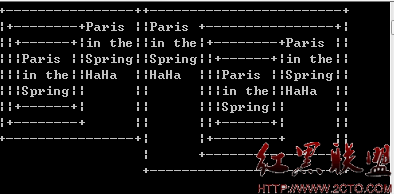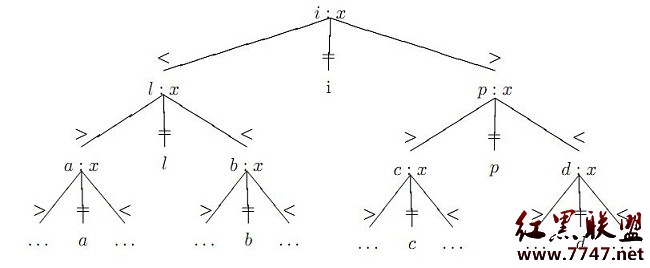UVA 705 Slash Maze
Slash Maze
By filling a rectangle with slashes (/) and backslashes ( ), you can generate nice little mazes. Here is an example:

As you can see, paths in the maze cannot branch, so the whole maze only contains cyclic paths and paths entering somewhere and leaving somewhere else. We are only interested in the cycles. In our example, there are two of them.
Your task is to write a program that counts the cycles and finds the length of the longest one. The length is defined as the number of small squares the cycle consists of (the ones bordered by gray lines in the picture). In this example, the long cycle has length 16 and the short one length 4.
Input
The input contains several maze descriptions. Each description begins with one line containing two integers w and h ( ), the width and the height of the maze. The next h lines represent the maze itself, and contain w characters each; all these characters will be either ``/" or ``\".
The input is terminated by a test case beginning with w = h = 0. This case should not be processed.
Output
For each maze, first output the line ``Maze #n:'', where n is the number of the maze. Then, output the line ``kCycles; the longest has length l.'', where k is the number of cycles in the maze and l the length of the longest of the cycles. If the maze does not contain any cycles, output the line ``There are no cycles.".
Output a blank line after each test case.
Sample Input
6 4
\//\\/
\///\/
//\\/\
\/\///
3 3
///
\//
\\\
0 0
Sample Output
Maze #1:
2 Cycles; the longest has length 16.
Maze #2:
There are no cycles.
题意:输入'/'、'\'组合成一个迷宫。。要找出迷宫中可以形成回路的回路个数和回路中最长的回路长度。。。
思路:这里用了2个方法。。。
第一个方法是: 把迷宫每一个格子转换成3 *3的格子。。斜线的格子用1表示,其余用0表示,每个格子保存好后。在新的地图进行搜索。这样就可以广搜BFS。如果地图中为0点的点可以走出边界。就是不可能形成回路。
如果不会走出边界。就必然可以形成回路,每次搜完一点后,把相邻的一片标记掉。就不用重复搜索了。如果搜索到可以形成回路的。他的长度为走过的格子数除以3。
#include <stdio.h>
#include <string.h>
int n, m;
int d[4][2] = {{-1, 0}, {0, 1}, {1, 0}, {0, -1}};
int map[275][275];
int maxx;
char sb;
struct Q
{
int x;
int y;
} q[66666];
int vis[275][275];
int numc;
void bfs(int x, int y)
{
memset(q, 0, sizeof(q));
memset(vis, 0, sizeof(vis));
int h = 0;
int r = 1;
int num = 1;
q[h].x = x;
q[h].y = y;
vis[x][y] = 1;
while (h < r)
{
for (int i = 0; i < 4; i ++)
{
int xx = q[h].x + d[i][0];
int yy = q[h].y + d[i][1];
if (xx < 0 || xx >= 3 * n || yy < 0 || yy >= 3 * m)
{
return;
}
if (map[xx][yy] == 0 && vis[xx][yy] == 0)
{
vis[xx][yy] = 1;
q[r].x = xx;
q[r].y = yy;
num ++;
r ++;
}
}
h ++;
}
numc ++;
if (maxx < num / 3)
maxx = num / 3;
}
void bfs2(int x, int y)
{
memset(q, 0, sizeof(q));
int h = 0;
int r = 1;
q[h].x = x;
q[h].y = y;
map[x][y] = 1;
while (h < r)
{
for (int i = 0; i < 4; i ++)
{
int xx = q[h].x + d[i][0];
int yy = q[h].y + d[i][1];
if (map[xx][yy] == 0 && xx >= 0 && xx < 3 * n && yy >= 0 && yy < 3 * m)
{
map[xx][yy] = 1;
q[r].x = xx;
q[r].y = yy;
r ++;
}
}
h ++;
}
}
int main()
{
int tt = 1;
while (scanf("%d%d", &m, &n) != EOF && n + m)
{
maxx = 0;
numc = 0;
memset(map, 0, sizeof(map));
getchar();
for (int i = 0; i < n; i ++)
{
for (int j = 0; j < m; j ++)
{
scanf("%c", &sb);
if (sb == '\\')
{
map[i * 3][j * 3] = 1;
map[i * 3 + 1][j * 3 + 1] = 1;
map[i * 3 + 2][j * 3 + 2] = 1;
}
if (sb == '/')
{
map[i * 3][j * 3 + 2] = 1;
map[i * 3 + 1][j * 3 + 1] = 1;
map[i * 3 + 2][j * 3] = 1;
}
}
getchar();
}
for (int i = 0; i < 3 * n; i ++)
{
for (int j = 0; j < 3 * m; j ++)
{
if (map[i][j] == 0)
{
bfs(i, j);
bfs2(i, j);
}
}
}
printf("Maze #%d:\n", tt ++);
if (numc)
printf("%d Cycles; the longest has length %d.\n\n", numc, maxx);
else
printf("There are no cycles.\n\n");
}
return 0;
}
第二个方法是:跟物理中的光学有关。。其实可以把每个墙壁看成镜子,路径看成光线。光射入镜子以后反射的路径是唯一的。然后每次就按照这个路径搜索。。如果会射出边界。。那么这条路径不可取。如果回射回起点,表明有回路。。这个方法写起来比较烦。要考虑墙壁是‘\','/'和路径入射方向。。但是时间比上一个方法快了许多。
#include <stdio.h>
#include <string.h>
int bo;
int n, m;
int xxx, yyy;
int www;
int numc;
int d[4][2] = {{-1,0},{0,1},{1,0},{0,-1}};
char map[80][80];
int vis[2][80][80];
int maxx;
void dfs(int x, int y, int f, int w, int bu)
{
if (x < 1 || x > n || y < 1 || y > m)
return;
if (bo == 0)
bo = 1;
else
{
if (x == xxx && y == yyy && w == www)
{
numc ++;
if (maxx < bu)
maxx = bu;
return;
}
}
vis[w][x][y] = 1;
int xx = x + d[f][0];
int yy = y + d[f][1];
if (f == 0)
{
if (map[xx][yy] == '\\')
{
dfs(xx, yy, 3, 1, bu + 1);
}
if (map[xx][yy] == '/')
{
dfs(xx, yy, 1, 1, bu + 1);
}
}
if (f == 1)
{
if (map[xx][yy] == '\\')
{
dfs(xx, yy, 2, 1, bu + 1);
}
if (map[xx][yy] == '/')
{
dfs(xx, yy, 0, 0, bu + 1);
}
}
if (f == 2)
{
if (map[xx][yy] == '\\')
{
dfs(xx, yy, 1, 0, bu + 1);
}
if (map[xx][yy] == '/')
{
dfs(xx, yy, 3, 0, bu + 1);
}
}
if (f == 3)
{
if (map[xx][yy] == '\\')
{
dfs(xx, yy, 0, 0, bu + 1);
}
if (map[xx][yy] == '/')
{
dfs(xx, yy, 2, 1, bu + 1);
}
}
}
int main()
{
int tt = 1;
while (scanf("%d%d", &m, &n) != EOF && n + m)
{
maxx = 0;
numc = 0;
getchar();
memset(map, 0, sizeof(map));
memset(vis, 0, sizeof(vis));
for (int i = 1; i <= n; i ++)
{
gets(map[i] + 1);
}
for (int i = 1; i <= n; i ++)
for (int j = 1; j <= m; j ++)
{
xxx = i; yyy = j;
if (vis[0][i][j] == 0)
{
www = 0;
bo = 0;
dfs(i, j, 0, 0, 0);
if (map[i][j] == '/')
{
bo = 0;
dfs(i, j, 3, 0, 0);
}
if (map[i][j] == '\\')
{
bo = 0;
dfs(i, j, 1, 0, 0);
}
}
if (vis[1][i][j] == 0)
{
www = 1;
if (map[i][j] == '/')
{
bo = 0;
dfs(i, j, 1, 1, 0);
}
if (map[i][j] == '\\')
{
bo = 0;
dfs(i, j, 3, 1, 0);
}
bo = 0;
dfs(i, j, 2, 1, 0);
}
}
printf("Maze #%d:\n", tt ++);
if (numc)
printf("%d Cycles; the longest has length %d.\n\n", numc / 2, maxx);
else
printf("There are no cycles.\n\n");
}
return 0;
}
补充:软件开发 , C++ ,




